
Change ringing is the art of ringing a set of tuned bells in a tightly controlled manner to produce precise variations in their successive striking sequences, known as "changes". This can be by method ringing in which the ringers commit to memory the rules for generating each change, or by call changes, where the ringers are instructed how to generate each change by instructions from a conductor. This creates a form of bell music which cannot be discerned as a conventional melody, but is a series of mathematical sequences.
Campanology is the scientific and musical study of bells. It encompasses the technology of bells – how they are founded, tuned, and rung – as well as the history, methods, and traditions of bellringing as an art.
Method ringing is a form of change ringing in which the ringers commit to memory the rules for generating each change of sequence, and pairs of bells are affected. This creates a form of bell music which is continually changing, but which cannot be discerned as a conventional melody. It is a way of sounding continually changing mathematical permutations.

St Peter Mancroft is a parish church in the Church of England, in the centre of Norwich, Norfolk. After the two cathedrals, it is the largest church in Norwich and was built between 1430 and 1455. It stands on a slightly elevated position, next to the market place.
The Oxford University Society of Change Ringers, founded in 1872, is the official society dedicated to change ringing in Oxford University. Its objects are to promote the art of change ringing in the university and to ring for Sunday services in Oxford during full term.

The Manchester Universities Guild of Change Ringers is a bell ringing guild based in Greater Manchester, whose home tower is the Sacred Trinity in Salford. Most of the members are, or have been in the past, students attending the universities and colleges in Manchester and Salford. The guild is a member of the Northern Universities Association.

The Nottingham University Society of Change Ringers (NUSCR) is one of the oldest societies affiliated to the University of Nottingham Students' Union, being founded in 1958. Its principal aim is to allow students from both the University of Nottingham and Nottingham Trent University to practise English Change Ringing. It also represents the University at the annual Northern Universities Association (NUA) Striking Competition each November.
The Ancient Society of College Youths (ASCY) is a change ringing society, founded in 1637 and based in the City of London. The society played a leading role in the early development of change ringing, and today, it provides ringers for important events at St Paul's Cathedral and Westminster Abbey. Although it is a non-territorial association, its importance is recognised through having four representatives on the Central Council of Church Bell Ringers.

In campanology, a peal is the special name given to a specific type of performance of change ringing which meets certain exacting conditions for duration, complexity and quality.
Call change ringing is a branch of the art of change ringing, in which a group of English-style full-circle bell ringers are instructed continually to create different sequences, or changes, of the bells' striking order. Each command from the leader or "conductor" of the ringing results in a new sequence of sounding the bells. Each sequence is repeated until the next command or "call".

The Minster Church of All Saints or Rotherham Minster is the Anglican minster church of Rotherham, South Yorkshire, England. The Minster is a prominent example of Perpendicular Gothic architecture and various architectural historians have rated it highly. Nikolaus Pevsner describes it as "one of the largest and stateliest churches in Yorkshire", Simon Jenkins states it is "the best work in the county", and Alec Clifton-Taylor calls it the "glory of Rotherham". With its tall spire, it is Rotherham's most predominant landmark, and amongst the tallest churches in Yorkshire.
Fabian Stedman (1640–1713) was an English author and a leading figure in the early history of campanology, particularly in the field of method ringing. He had a key role in publishing two books Tintinnalogia and Campanalogia which are the first two publications on the subject. He is also regarded as being a pioneer in the branch of mathematics known as Group theory.

The University of Bristol Society of Change Ringers (UBSCR) is a change ringing society. UBSCR is associated with the University of Bristol and is affiliated to Bristol SU. UBSCR was established in 1943 and has rung bells at St Michael on the Mount Without since 1944. Since 1950 there have been over 700 peals rung for the society. UBSCR is also affiliated to the Central Council of Church Bell Ringers and sends two representatives to its AGM.
John Holt was a leading change ringer and noted composer of peals on English full circle bells in the 18th century, and is described as a composer "..holding a position which is unique in the history of change ringing".

A peal board records on a wooden, metal, stone or canvas plaque a peal rung on church bells.
The Church of St Matthias is an Anglican place of worship in Malvern Link, England. Prior to the establishment of this church, the residents of Malvern Link had to walk 3 miles to their parish church, St. Edburga's Church in Leigh. The Rector of Leigh, Henry Somers-Cocks, requested the 2nd Earl Somers to provide some land for a new church, which he did on 27 December 1843, the form of Link Meadow.
Albert John Pitman is regarded by change ringing campanologists as a remarkable and versatile composer of peals in bell ringing methods. Described as 'perhaps the greatest of all time' in the Central Council of Church Bell Ringers biography of him, An Unassuming Genius, he was an extraordinary talent in the field of peal composition.
In method ringing, a branch of change ringing, the ringing pattern known as plain hunt is the simplest method of generating continuously changing sequences, and is a fundamental building-block of method ringing.

The Norman Tower, also known as St James' Gate, is the detached bell tower of St Edmundsbury Cathedral, Bury St Edmunds, Suffolk. Originally constructed in the early 12th century as the gatehouse of the vast Abbey of Bury St Edmunds, it is one of only two surviving structures of the Abbey, the other being Abbey Gate, located 150 metres to the north. The Abbey itself lies in ruins, approximately 200 metres to the east. As a virtually unaltered structure of the Romanesque age, the tower is both a Grade I listed building and a Scheduled Ancient Monument. The tower is considered amongst the finest Norman structures in East Anglia.
Campanology is the scientific and musical study of bells. It encompasses the technology of bells – how they are cast, tuned, and rung – as well as the history, methods, and traditions of bellringing as an art. Articles related to campanology include:









